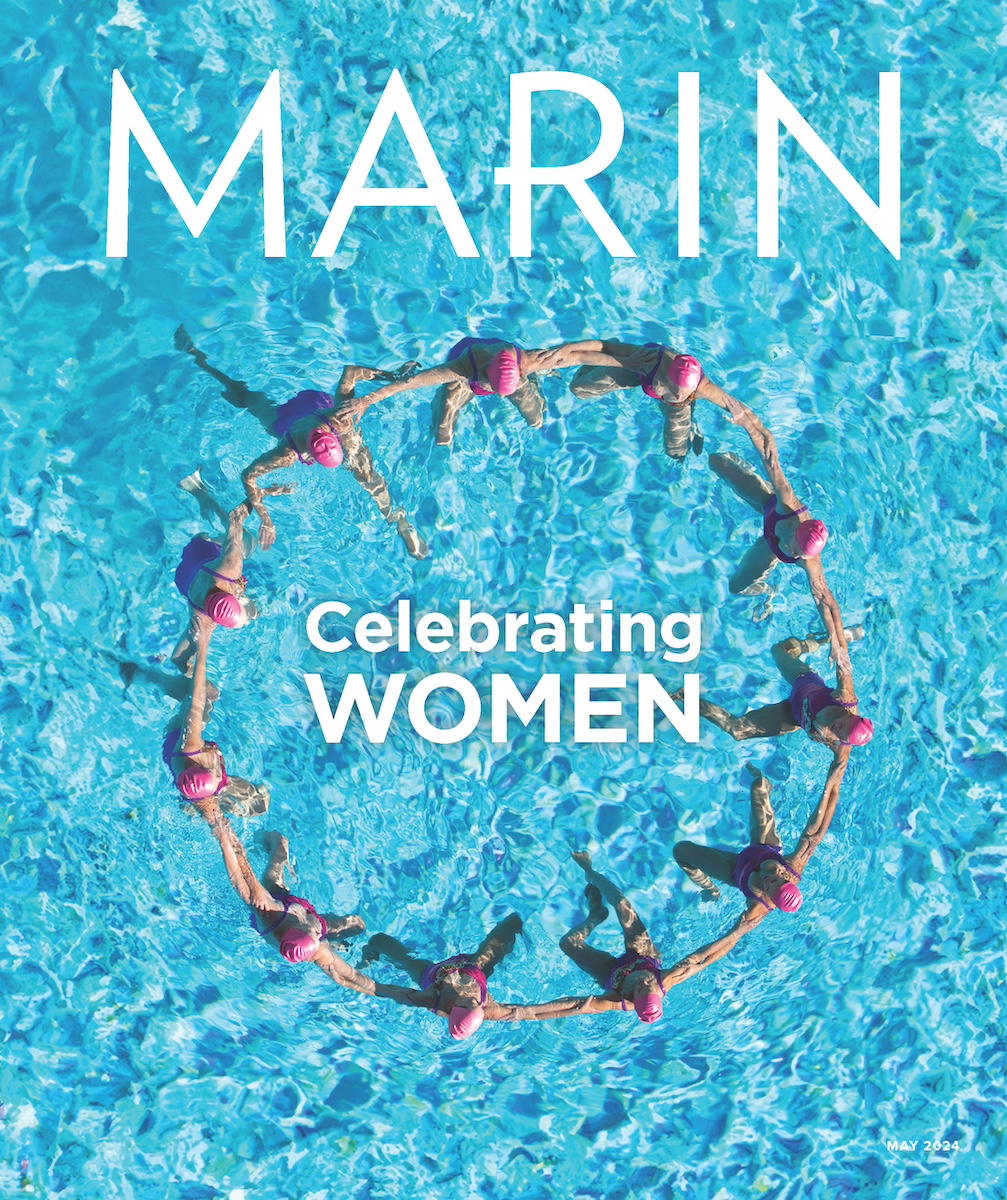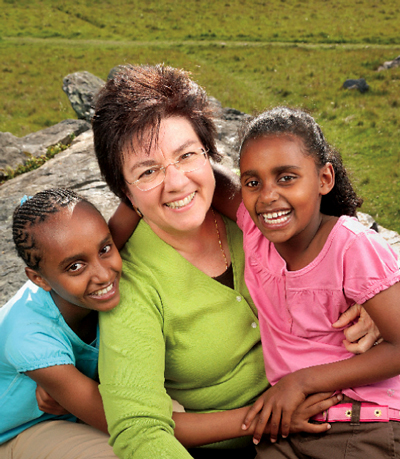For a better understanding of the proverb “still waters run deep,” spend some time with Marilee Eckert. Her voice is soft, her thoughts well formed, and she never rushes the conversation. When talking, seldom does she gesture. At 54, Eckert has worked all her adult life with young people, from the at-risk to the disadvantaged to the learning impaired. Today she’s executive director of the 120-person Marin Conservation Corps. The San Rafael nonprofit aims to connect young people with their communities through a work experience that “teaches them to become voices for a just and fair environment, one in which they can get their lives back on track.” After being around Eckert for an afternoon, you see she not only agrees with those words; she lives them.
Marin Conservation Corps collects recyclables from county, state and national parks, creates firebreaks, restores hiking trails, and removes nonnative vegetation for such entities as the Marin Open Space District, Marin Municipal Water District and Golden Gate National Recreation Area. Its annual $5.6 million budget comes primarily from funds raised through service contracts, government grants and private donations. The organization is expanding into Sonoma County and within the year will be renamed Conservation Corps North Bay.
Eckert has received acclaim for her work, including honors from the county Board of Supervisors and the Marin American Indian Alliance. But her other full-time commitment to young people is more personal. Nine years ago she and her longtime partner, Tina Cheplick, adopted two sisters from Ethiopia: Zehara, now 18, and Jemila, now 19. In 2004 the couple and their two daughters flew to Addis Abba and adopted two more sisters: Merone, now 9, and Woubidil, now 11 (pictured with Eckert).
“After 20 years, Tina and I had looked around our home and realized we had so much and the situation for young people in the world was so dire,” says Eckert, who lives in the neighborhood of Santa Venetia in San Rafael. “It only felt natural to try to help.”
Eckert rolls out statistics to convey why she chose to adopt a young child and not an infant, and why from Ethiopia: 133 million children worldwide orphaned by wars and diseases; an Ethiopian literacy rate for women of 17 percent; an average life span there of just 45 years. “We felt the need was greater for adopting impoverished youngsters without parents.” The process itself was lengthy and bureaucratic: “It took over eight months to get everything done, about the length of a normal pregnancy,” she says.
When you adopted the first two girls nine years ago, was that a leap of faith? Well, yes. At the time a friend had adopted an infant from China and sent me a photo of the two of them. They looked so happy and I was intrigued about how these two souls came together. How did a baby born in China connect with parents in Boston? Back then I didn’t have kids—and I had plenty of time—so I started looking at adoption pages on the Internet. After my partner and I settled on Ethiopia and not adopting babies, we agreed to adopt birth sisters between 6 and 12 years old.
The Ethiopians didn’t have much available technology; then suddenly one day, working with an adoption agency, we were sent photos of Zehara and Jemila and were asked, “How about these two?” We thought they looked fine but wanted more information. We were told they were 7 and 9 years old, but we thought they looked older. “Yeah, they probably are,” they told us. When we asked about their health, the only answer we got was, “Well, they seem healthy.” We didn’t know anything about their parents, other than it was thought they died of tuberculosis. All we had were two pictures and first names. Yet somehow there was a connection. I don’t know how to describe it.
Has their adoption been a success? Definitely. When we took off heading home, their eyes were big as saucers. I had studied Amharic, the most common Ethiopian language, and they knew a little English, so we had a basis for communicating. But at first there was a period of adjustment. They were in a whole new culture and learning a new language. Also, at ages 8 and 10 they had expectations that America was the land of plenty and they’d have everything they ever dreamed of. Jemila, the oldest girl, had the hardest time, because she went into the fifth grade and was expected right away to fit in and catch up. It’s easier when you start young, at a lower grade level.
However, they’re both really smart kids, beautiful girls. They got good grades at Terra Linda High School and now Jemila is going to Cal State East Bay and talking about getting her master’s at Cal Berkeley. Zehara is still at Terra Linda. She also wants to go to college and become a medical researcher who’ll someday find a cure for AIDS and tuberculosis. If we had any problems at all with the girls, it was having to make them stop studying. They were so motivated they had a tendency to become perfectionists.
Then five years later, in 2004, you adopted a second pair of sisters. Why? Our first two girls, almost from the start, kept asking, “When are you going to get us some brothers and sisters?” In Ethiopia there are lots of kids in the families. In selecting Merone, who was 5, and Woubidil, who was 7, we had a bit more information than with the first two. Their parents had died of AIDS and, due to a quirk in their housing placement, these two girls were not living together. We thought it would be nice to bring them back together in a family environment. Still, it was a heartbreaking process. So many children without their birth parents want to come to America. The older girls started to help with the process, but after a while it became overwhelming for them. “You just do it,” they told Tina and me. Then, once we decided on Merone and Woubidil, all four of us flew to Ethiopia to pick them up.
It was the trip of a lifetime. For three weeks we rented a house and people were constantly dropping by. The older girls got to say hi to their friends while the younger girls said good-bye to their friends. Merone is now 9 and Woubidil is 11, and they both attend Venetia Valley School and are doing really well. Like their older sisters, they get good grades. Both are sweet kids and seem like old souls because to me they have such great wisdom. Woubidil loves to play basketball; she made the CYO “A” team this year.
And Merone never ceases to amaze me. The other day, her teacher asked the class what each student would do with a thousand dollars. Merone answered that she’d buy food for people who are hungry. Then she added, “That’s because my mom buys me everything I need.” I liked that it wasn’t “everything I want,” but “everything I need.”
You’ve now had four girls in your family for four years. How’s that going? For the most part fine. The older girls didn’t realize how things would change once younger girls were in the family. For example, when we watch TV programs, it’s only programs that are suitable for the younger ones, which upsets the older kids. There are the normal sibling rivalries, but nothing serious. They have their chores: the teens do the dishes and the laundry; the little ones take out the trash and restock the supplies in the bathrooms. Merone, the youngest one, wants to cook meals for the family, but she needs a lot of help.
Will the six of you do anything special on Mother’s Day? It will be a little different this year because Jemila won’t be there. She’ll probably be staying at her school, where she lives in the dorm. And that’s good. I like that. I want her to develop her own friends and make her own way. But usually on Mother’s Day the girls will clean the house, make signs, give us cards, and often they make a special breakfast. If not, they’ll just hang around and not make any plans of their own so we can be together as a family. And they’ll each have a gift to give. It’s all very sweet.
What do your girls call you? Oh, Mom, of course. And it sounds so natural. When we’re in a group, they seem to say “Mom” even louder and more often. It’s like they want everyone to know that we’re a family. Which is nice. I like it that way.
Any advice for people contemplating adopting older children from different cultures, of different races? First, it takes a lot of work and dedication and therefore has to be a personal decision. It’s important to thoroughly think through the adoption question. Realize, if you’re considering multiple adoptions, that each child needs his/her own amount of attention and support. All adopted kids are special-needs kids because they have a lot of emotional pieces that need bringing together. They’ve lost their parents and, when it’s an international adoption, they’ve lost their country and their culture. So it takes sensitivity, it takes support, and let’s be honest, it takes money. Next year we’ll have two girls in college and two requiring after-school care and summertime activities. But it can also be really rewarding. I’m so blessed to have these young talented and beautiful beings in my life. It’s been an amazing experience.


